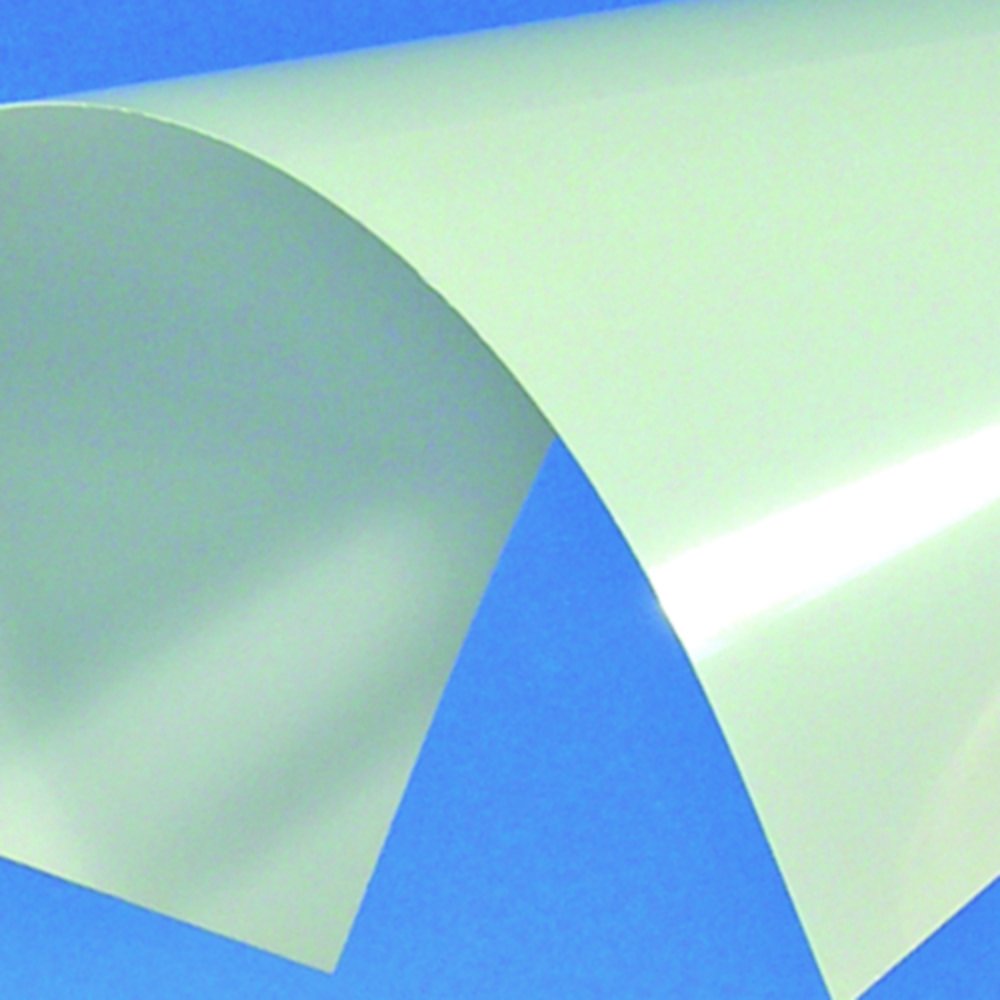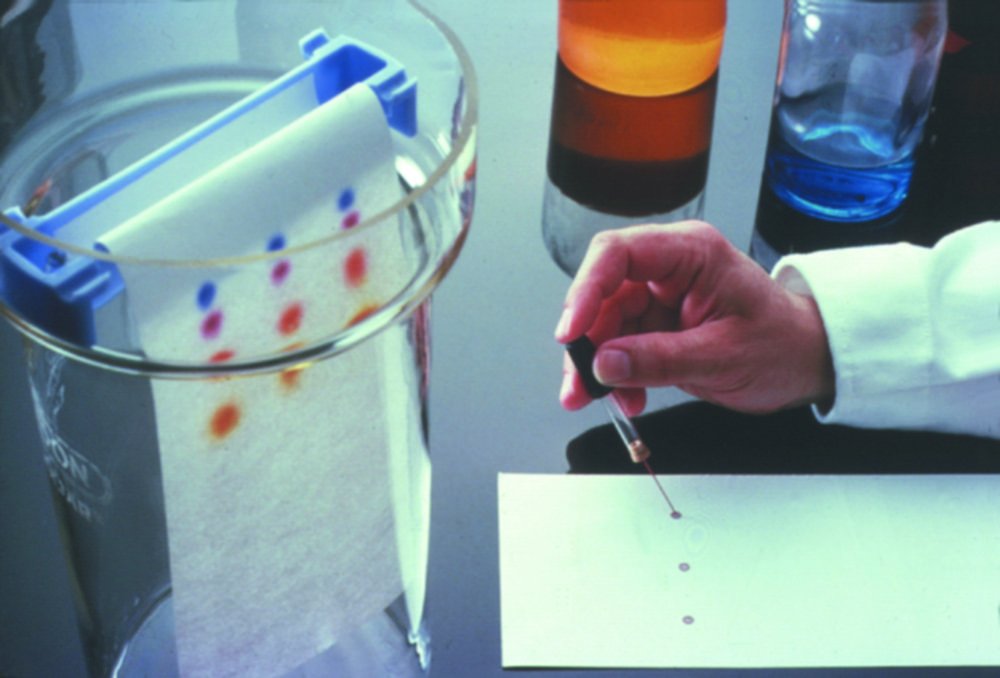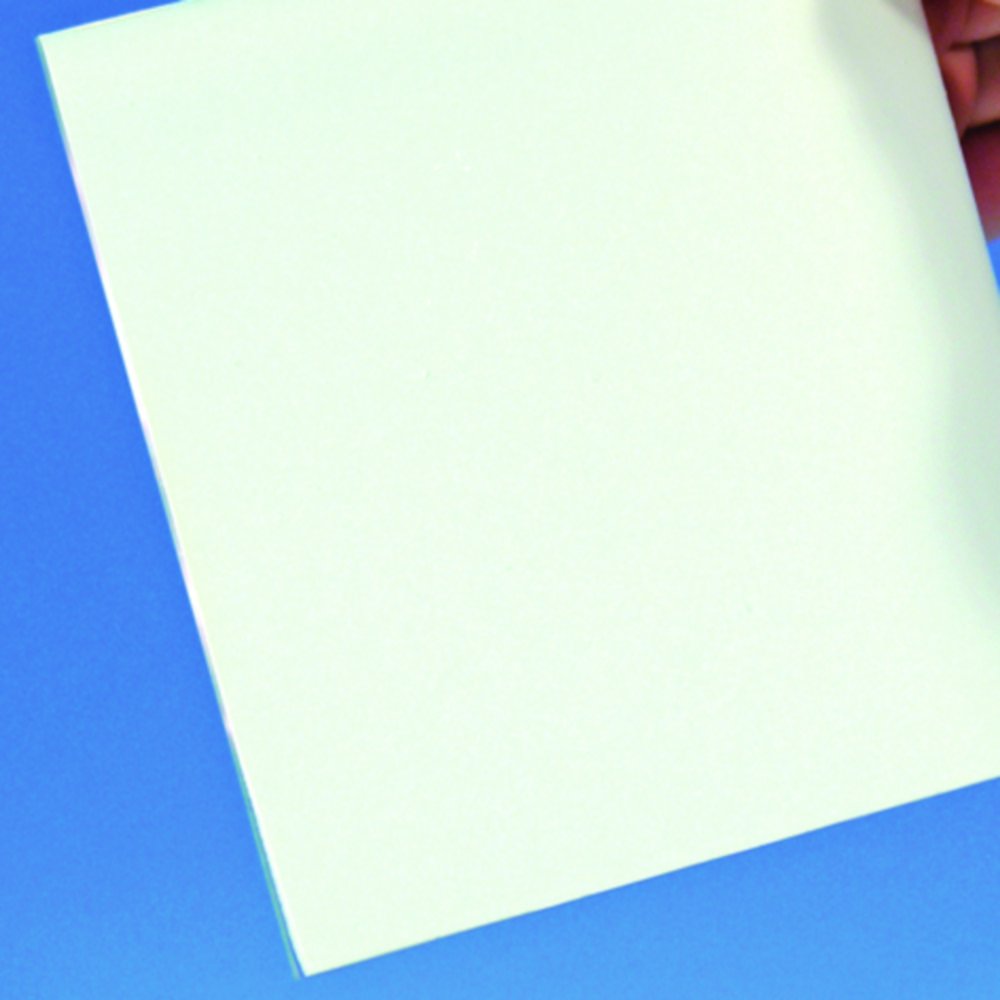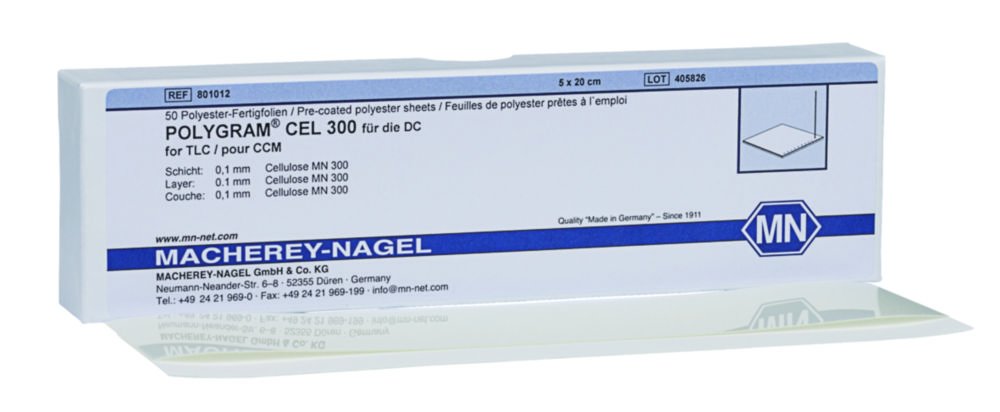TLC plates Silica gel 60 F254, with concentrating zone | Plate format cm: 20 x 20
Merck KGaA


CHF 276.00*
Content:
25
Delivery according to order confirmation
Product number:
9130064
Manufacturer:
Merck KGaA
Weight:
0.4 kg
* Specifications refer to the packaging unit

Inorganic fluorescent indicators, green fluorescing.
| Gel thickness mm: | 0.20 |
|---|---|
| Material: | Aluminium |
| Plate format cm: | 20 x 20 |
| Preview | Product number | Gel thickness mm | Material | Content | Unit price | Delivery time | Buy |
|---|
Other customers also bought
Merck KGaA
TLC plates, Silica gel 60 F254
Inorganic fluorescent indicators, green fluorescing.
Merck KGaA
TLC plates Silica gel 60 RP-18 F254S
Inorganic fluorescent indicators, blue fluorescing, acid-stable.
Merck KGaA
TLC plates LuxPlate® Silica gel 60 F254
Inorganic fluorescent indicators, green fluorescing.
Merck KGaA
TLC plates, Kieselguhr F254
Inorganic fluorescent indicators, green fluorescing.
Merck KGaA
TLC plates Silica gel 60 RP-8 F254S
Inorganic fluorescent indicators, blue fluorescing, acid-stable.
Similar products
Support materials for TLC ready-to-use layersGlass plates: glass, ~ 1.3 mm thick, high requirements for weight, packaging and storage, ideal torsional strength, high temperature stability, susceptible to breakage, can not be cut with scissors, high resistance against solvents, mineral acids and conc. ammonia, suitability for aqueous detection reagents depends on the phasePOLYGRAM®: polyester, ~ 0.2 mm thick, low requirements for weight, packaging and storage, low torsional strength, max. 185 °C temperature stability, not susceptible to breakage, can be cut with scissors, high resistance against solvents, mineral acids and conc. ammonia, very suitable for aqueous detection reagentsALUGRAM®: aluminium, ~ 0.15 mm thick, low requirements for weight, packaging and storage, relatively high torsional strength, high temperature stability, not susceptible to breakage, can be cut with scissors, high resistance against solvents, low resistance against mineral acids and conc. ammonia, limited suitability for aqueous detection reagentsGlass plates, POLYGRAM®, ALUGRAM®Silica 60Specific surface (BET) ~500 m²/gMean pore size 60 ÅSpecific pore volume 0.75 ml/gParticle size 5 to 17 µmStandard gradeThickness of layer for analytical plates 0.25 mm, for preparative plates 0.5 and 1 mmFor 2 mm preparative layers a slightly coarser material is used, indicators: manganese activated zinc silicate with green fluorescence for short-wave UV (254 nm)Binders: highly polymeric products, which are stable in almost all organic solvents and resistant towards aggressive visualisation reagentsBinder system for Polygram® sheets is also completely stable in purely aqueous eluentsAvailable as glass plates, Polygram polyester sheets and Alugram aluminium sheetsAvailable with or without fluorescent indicator (UV 254)
Merck KGaA
TLC plates, Silica gel 60 F254
Inorganic fluorescent indicators, green fluorescing.
Whatman chromatography papers are the most widely used papers for chromatography worldwide. This acceptance and usage reflects the purity, high quality and consistency of Whatman papers. These qualities are relied upon by chromatographers and essential to successful reproducible chromatography. Whatman chromatography paper media are made from specially selected cotton cellulose. They are rigorously quality controlled for characteristics important to the chromatographer and to ensure uniformity within the grade.1 Chr world standard chromatography paper. A smooth surface, 0.18 mm thick with a linear flow rate (water) of 130 mm/30 min. Good resolution for general analytical separations.3MM Chr widely used as a blotting paper, 3MM Chr is used in both electrophoresis and for general chemistry. A medium thickness paper (0.34 mm) used extensively for general chromatography and electrophoresis. Flow rate is 130 mm/30 min.3 Chr medium thickness paper (0.34 mm) with a flow rate of 130 mm/30 min. For general applications with medium/heavy solute loadings. Frequently used for separation of inorganic compounds and for electrophoresis.17 Chr thick (0.92 mm) and highly absorbent paper with a very high flow rate of 190 mm/30 min. Suitable for the heaviest loadings and ideal for preparative paper chromatography and electrophoresis.Ion exchange paperSG81: A unique paper (0.27 mm thick) combining cellulose and large pore silica gel. Suitable for separations in which both partition and adsorption are important, including the separation of phospholipids, steroids, phenols and dyes. Flow rate is 110 mm/30 min.
ALUGRAM®Base material: Nano-K silica 60, specific surface (BET) ~500 m²/g, mean pore size 60 Å, specific pore volume 0.75 ml/g, particle size 2 to 10 µm; for preparative plates (1 mm thickness of layer) standard silica 60, particle size 5 to 17 µm, pH stability 2 to 10 indicator: acid-resistant product with a pale blue fluorescence for short-wave UV (254 nm); UV-absorbing substances apppear as dark-blue to black spots on a light-blue background; partial octadecyl modification, wettable with water, carbon content 14 %. 18-100 normal phase or reversed phase separation modes with eluents from anhydrous solvents to mixtures with high concentrations of water (see figure); the relative polarity of the eluent determines the polarity of the layer.Recommended application: aminophenols, barbiturates, preservatives, nucleobases, polycyclic aromatic hydrocarbons, steroids, tetracyclines, plasticizers (phthalates).Available as glass plates with or without fluorescent indicator (UV 254).Glass plates available on request.
The primary field of application is the partition chromatography of polar substances such as amino acids, carboxylic acids or carbohydrates. The TLC-plates are available as glass plates, POLYGRAM® polyester sheets and ALUGRAM® aluminium sheets.Fiber length (95 %) 2-20 µmAverage degree of polymerization 400-500Specific surface according to Blaine 15000 cm2/g≤ 20 ppm Fe, 6 ppm Cu, 7 ppm PDichloromethane extract ≤ 0.25 %Residue on ignition at 850 °C ≤ 1500 ppmAvailable with or without fluorescent indicator (UV 254)
Support materials for TLC ready-to-use layersGlass plates: glass, ~ 1.3 mm thick, high requirements for weight, packaging and storage, ideal torsional strength, high temperature stability, susceptible to breakage, can not be cut with scissors, high resistance against solvents, mineral acids and conc. ammonia, suitability for aqueous detection reagents depends on the phasePOLYGRAM®: polyester, ~ 0.2 mm thick, low requirements for weight, packaging and storage, low torsional strength, max. 185 °C temperature stability, not susceptible to breakage, can be cut with scissors, high resistance against solvents, mineral acids and conc. ammonia, very suitable for aqueous detection reagentsALUGRAM®: aluminium, ~ 0.15 mm thick, low requirements for weight, packaging and storage, relatively high torsional strength, high temperature stability, not susceptible to breakage, can be cut with scissors, high resistance against solvents, low resistance against mineral acids and conc. ammonia, limited suitability for aqueous detection reagentsSilica 60, specific surface (BET) ~ 500m²/g, mean pore size 60Å, specific pore volume 0.75ml/g, particle size 5 to 17µm. Outstanding hardness and abrasion resistance due to an optimized binder system. Increased separation efficiency due to an optimized particle size distirbution. High suitability for trace analyses resulting from a UV indicator with brilliance and a low-noise background of the layer.Available as glass plates with or without fluorescent indicator (UV254).
Recommended for chromatographic analysis and preparations.Made from pure linters with an α-cellulose content of > 98%High-performance resolution and wet strengthThe fibres are oriented in predominantly one directionThicker papers allow higher sample volumesLower capillary rises offer higher resolutions
Support materials for TLC ready-to-use layersGlass plates: glass, ~ 1.3 mm thick, high requirements for weight, packaging and storage, ideal torsional strength, high temperature stability, susceptible to breakage, can not be cut with scissors, high resistance against solvents, mineral acids and conc. ammonia, suitability for aqueous detection reagents depends on the phasePOLYGRAM®: polyester, ~ 0.2 mm thick, low requirements for weight, packaging and storage, low torsional strength, max. 185 °C temperature stability, not susceptible to breakage, can be cut with scissors, high resistance against solvents, mineral acids and conc. ammonia, very suitable for aqueous detection reagentsALUGRAM®: aluminium, ~ 0.15 mm thick, low requirements for weight, packaging and storage, relatively high torsional strength, high temperature stability, not susceptible to breakage, can be cut with scissors, high resistance against solvents, low resistance against mineral acids and conc. ammonia, limited suitability for aqueous detection reagentsALUGRAM®Nano silica 60, specific surface (BET) ~ 500m²/g, mean pore size 60Å, specific pore volume 0.75ml/g, particle size 2 to 10µm. Indicator: manganese activated zinc silicate with green fluorescence for short-wave UV (254nm).Binder: highly polymeric product, which is stable in almost all organic solvents and resistant towards aggressive visualisation reagents. Narrow fractionation of the silica particles allows sharper separations, shorter developing times, shorter migration distances, smaller samples and an increased detection sensitivity compared to SIL G plates.Available as glass plates with or without fluorescent indicator (UV254).






